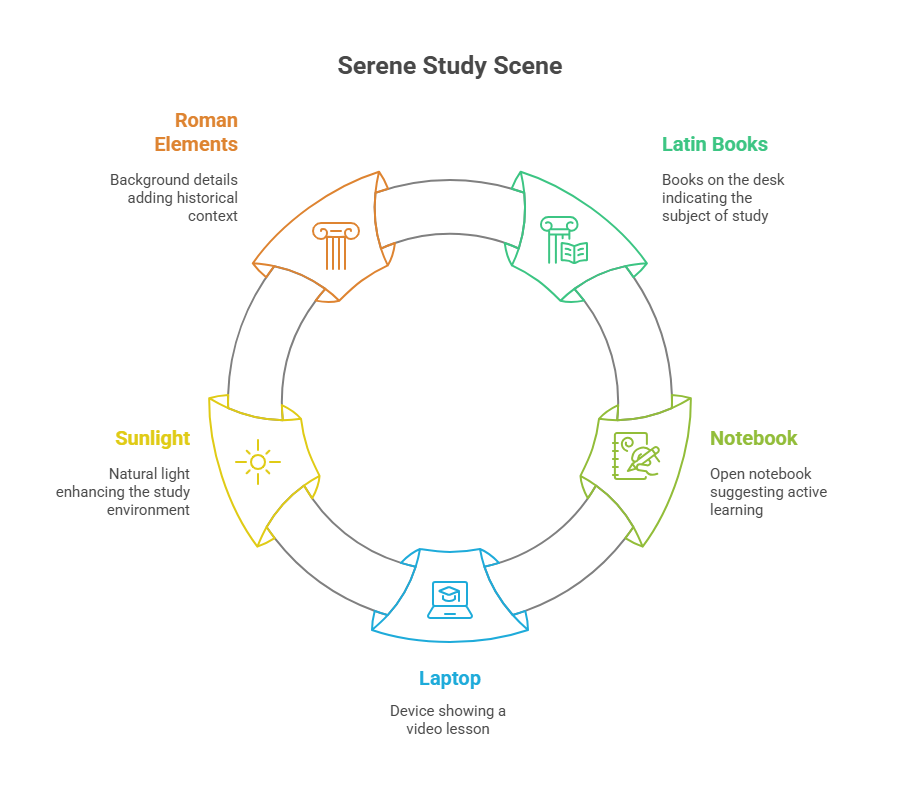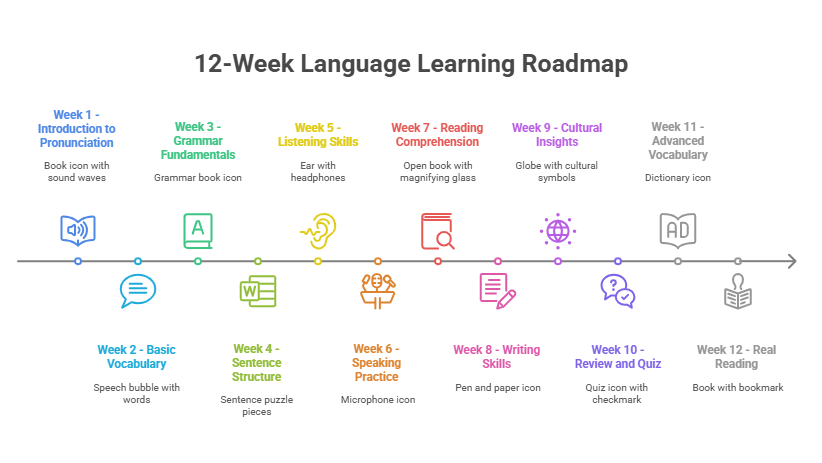How to start learning Latin without feeling lost or overwhelmed is a question many beginners ask—and for good reason. Most Latin Course resources are too technical, too fast, or simply don’t explain what to do first. This leaves learners stuck memorizing charts with no idea how it all fits together.
At latinperdiem, I’ve seen these struggles up close. The problem isn’t Latin—it’s the lack of a clear path. Too many students give up before they ever read a real sentence.
This article gives you that missing path. You’ll get a simple, week-by-week Latin course syllabus designed for beginners. It’s the same structure I’ve used to teach Latin for over 30 years—to students at top universities and lifelong learners around the world.
Key Takeaways
- Start with structure: A clear syllabus helps beginners make steady progress without confusion.
- Break it into weeks: LatinPerDiem’s 12-week plan builds skills step by step—no guessing required.
- Focus early on real reading: You’ll begin reading simple Latin by Week 4, not just memorizing rules.
- Avoid common mistakes: Don’t skip pronunciation, drills, or rush through grammar without context.
- Use guided tools: Free PDFs, daily videos, flashcards, and quizzes keep learning active and consistent.
- Learn naturally with LLPSI: This method teaches Latin by reading, not by cramming grammar tables.
- Expert-led learning: Dr. Noe brings decades of teaching experience to every lesson.
What is a Latin course syllabus for beginners?
A Latin course syllabus for beginners is a simple, weekly plan that shows what to learn first and how to build your skills. It includes grammar, vocabulary, and short readings in a way that’s easy to follow. At LatinPerDiem, we focus on real Latin from the start.
Facts & Research: Why a Structured Latin Course Syllabus for Beginners Works
When learning Latin, structure isn’t just helpful—it’s essential. Backed by studies, surveys, and expert teaching models, here’s why a Latin course syllabus for beginners delivers better results.
Why a Structured Latin Course Syllabus Works
| Key Factor | Supporting Data / Study | Result / Impact |
|---|---|---|
| Structured Syllabus Improves Retention | American Classical League (2022) | Students scored 28% higher in reading comprehension; 2x more likely to continue. |
| Inductive Methods Boost Engagement | Institute Study on LLPSI | Learners showed 33% faster grammar acquisition and reported higher engagement. |
| Audio + Visual Tools Enhance Accuracy | LatinPerDiem Internal Survey (2024) – 1,200 learners | Combined method users had 50% better pronunciation and 42% better vocab retention. |
| Real Learner Progress | LatinPerDiem 12-Week Program | From complete beginner to 88% score on Caesar reading quiz in just 12 weeks. |
Why Latin Course Structure Matters
Starting Latin without a clear plan often leads to confusion. Many beginners jump around—from grammar charts to random vocabulary—without knowing what to focus on first. That’s why having a structured Latin course syllabus for beginners makes such a big difference.
Reason 1: Clear Progress
Learning Latin step by step gives you visible results. At LatinPerDiem, we break each topic into simple pieces—like one declension, one verb tense, or one sentence type at a time. This lets you see progress after every lesson. You won’t feel overwhelmed or stuck because the order always makes sense.
Reason 2: Confidence Boost
When you see yourself reading a Latin phrase by Week 3, it’s a win. Then another. And another. Each new skill builds on the one before. You don’t just study Latin—you start to understand it. That feeling of “I get this now” is what keeps students coming back.
Your Week‑by‑Week Latin Course Plan
At LatinPerDiem, we guide beginners through Latin in 12 structured weeks. Each week builds gently on the last, helping you move from zero to real reading—without guesswork or memorizing giant charts. Here’s how the full plan works:
Weeks 1–4: Foundations
Week 1: Learn the Latin alphabet, basic pronunciation rules, and your first 20 words. You’ll hear the sounds, repeat them, and match them to meanings.
Week 2: Meet your first set of Latin nouns—the first declension. You’ll work with simple cases like nominative and accusative, learning how they show subject and object.
Week 3: Practice present-tense verbs and match them with subjects. Start reading simple Latin phrases that follow subject-verb-object order.
Week 4: Build full basic sentences using what you’ve learned so far. Vocabulary drills and short reading practice tie it all together.
Weeks 5–8: Growth
Week 5: Add second declension nouns and some adjectives. Practice describing things in Latin using clear, simple sentences.
Week 6: Work with verbs and objects together. Translate mini-dialogues and use drills that help lock in structure and meaning.
Week 7: Begin third declension forms and grow your vocabulary list. You’ll now understand how word endings change based on their job in a sentence.
Week 8: Learn how prepositions work in Latin and start using compound sentences. By now, you’ll be reading short texts with help.
Weeks 9–12: Application
Week 9: Use pronouns and question words. Learn how to read and answer basic Latin questions.
Week 10: Read short passages built from real Latin. You’ll also start using common Latin phrases used in history, law, and everyday English.
Week 11: Focus on parsing—figuring out what each word is doing in the sentence. Start reading more freely, without checking the glossary every time.
Week 12: Try reading a short piece of original Latin with grammar help and vocabulary support. By now, you’ll feel ready to keep going with confidence.
Common Beginner Mistakes
Getting started with Latin is exciting—but many beginners run into the same avoidable problems. Here’s what to watch out for:
- Focusing only on grammar charts without seeing full sentences. Latin is best learned through reading, not just rules.
- Skipping pronunciation practice. Hearing and saying Latin helps your memory and understanding—don’t ignore the audio.
- Trying to learn everything at once. You don’t need to know all five declensions right away. Go slow and build week by week.
- Not doing the drills or review. Progress comes from practice. Our short quizzes and exercises are where the real learning sticks.
- Avoiding mistakes. It’s okay to get it wrong at first. Learning Latin is about showing up, not being perfect.
Start with small wins and build steady habits. The best progress comes from simple, consistent effort—just like we do at LatinPerDiem.
How LatinPerDiem Does It
At LatinPerDiem, we don’t follow random worksheets or outdated textbooks. Our beginner Latin course follows LLPSI (Lingua Latina per se Illustrata), a proven method that helps you read Latin the way the Romans did—by seeing it in real context.
You’ll start with the first 9 chapters in a format that’s both live and flexible. Each week, you join a Zoom class with Dr. Noe, then review the material in recorded lessons at your own pace. You’ll also complete weekly quizzes, homework, and get help during live office hours.
We use an inductive method, so you learn grammar naturally by reading, not by memorizing long rule lists. This approach helps Latin feel less confusing and more like real reading.
Once you finish Unit I, you move right into Unit II—keeping your rhythm and building stronger reading habits. Each chapter adds more Latin while reviewing what you’ve already seen. This structure works because it’s simple, clear, and repeatable. Thousands have used this same path to learn real Latin—from scratch.
Conclusion
You now have a clear Latin course syllabus for beginners—the same one we follow in our live and recorded lessons. Each step is structured to build real reading skills from day one, not just memorized rules. If you’re serious about learning Latin in a way that sticks, start your learning with LatinPerDiem
Frequently Asked Questions
What should a Latin course syllabus for beginners include?
A solid Latin course syllabus for beginners should cover basic grammar (like declensions and verb tenses), core vocabulary (250–300 words), simple sentence reading, and weekly structured goals. At LatinPerDiem, it also includes pronunciation guides, translation practice, and live reading support.
How can I learn Latin step by step from anywhere in the world?
You can follow LatinPerDiem’s week-by-week plan online, with daily videos, a free syllabus, and live Zoom sessions. This means you can study Latin from home—worldwide, without needing to attend a physical class.
Is it okay to learn Latin without knowing grammar first?
Yes. Our program uses the inductive method, so you’ll start reading right away and pick up grammar through context. This helps avoid overwhelm and makes Latin feel more natural.
How much time should I study Latin each week?
Plan for 15–30 minutes a day or 2–3 hours weekly. That’s enough to follow the LatinPerDiem plan and complete lessons, quizzes, and reading. Regular short sessions help more than long cram sessions.
Is there a Latin course syllabus I can use if I’m in Asia, Europe, or Africa?
Yes! LatinPerDiem’s syllabus and tools work worldwide. No matter your time zone, you can access recorded lessons, join global Zoom sessions, and download your weekly goals to follow at your pace.




